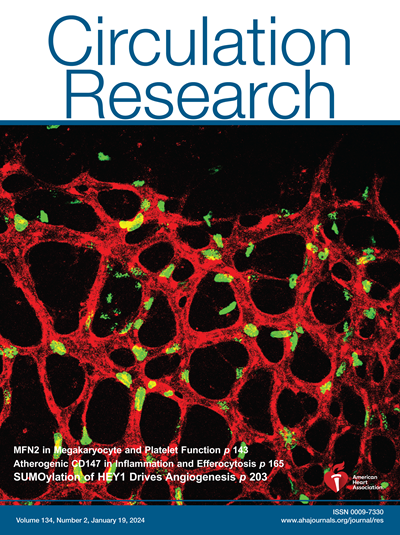SLC39A13 Regulates Heart Function via Mitochondrial Iron Homeostasis Maintenance.
IF 16.2
1区 医学
Q1 CARDIAC & CARDIOVASCULAR SYSTEMS
引用次数: 0
Abstract
BACKGROUND Iron is a necessary trace element for multiple reactions but is toxic in excess. Its intracellular balance is delicately maintained. We previously found that the loss of SLC39A13 (ZIP13), a newly identified endoplasmic reticulum/Golgi-resident iron transporter, impacted iron homeostasis in multiple tissues. The purpose of this study is to investigate the role of ZIP13 in regulating cardiac functions and the precise mechanism of cardiac injury caused by ZIP13 deficiency. METHODS Cardio-specific knockout of Zip13 (Zip13-CKO), tamoxifen-inducible Zip13 knockout (Zip13-iKO), and systemic (germline) Zip13 knockout mouse model were used to study the effect of Zip13 deletion on cardiac functions. These mice were analyzed for growth, cardiac systolic function, mitochondrial morphology, mitochondrial iron metabolism, and mitochondrial biogenesis and activity. We also generated cardio-specific ferroportin 1 (Fpn1-CKO) and Zip13&Fpn1 (Zip13&Fpn1-CKO) double-knockout mice to compare with Zip13-CKO mice. Mouse embryonic fibroblasts and primary cardiomyocytes were used for in vitro experiments. RESULTS Zip13-CKO mice displayed severe cardiac systolic dysfunctions. The mitochondrial function and morphology were markedly abnormal in Zip13-CKO cardiomyocytes, accompanied by cytosolic iron increase and mitochondrial iron decrease. These were also confirmed in vitro with mouse embryonic fibroblasts and primary cardiomyocytes. Moreover, iron supplementation or overexpressing MFRN1 (mitoferrin 1), a mitochondrial iron importer, could substantially restore the mitochondrial iron homeostasis and function of ZIP13-deficient primary cardiomyocytes, indicating mitochondrial iron dyshomeostasis underlies the observed cardiac abnormality. The Zip13-CKO did not wholly resemble that of Fpn1-CKO, which was associated with elevated cytosolic iron, but no statistically significant change was observed in mitochondrial iron. Zip13&Fpn1-CKO mice presented a more severe heart defect than either single mutant alone, likely due to a further aggravated iron accumulation in the cytosol of cardiomyocytes. CONCLUSIONS We propose that ZIP13 and FPN1 are both required to maintain cardiac functions via overlapping but different manners; FPN1 maintains the cytosolic iron by exporting iron out of the cells, while ZIP13 helps balance the iron equilibrium between the cytosol and the organellar network system, including the mitochondrion. These findings establish the critical role of ZIP13 in maintaining mitochondrial iron homeostasis and activity, enabling cardiomyocytes to perform effectively their essential roles.SLC39A13通过线粒体铁稳态维持调节心脏功能。
背景:铁是多种反应所必需的微量元素,但过量是有毒的。它的细胞内平衡被微妙地维持着。我们之前发现,SLC39A13 (ZIP13)是一种新发现的内质网/高尔基蛋白铁转运蛋白,其缺失会影响多种组织的铁稳态。本研究旨在探讨ZIP13在心脏功能调控中的作用,以及ZIP13缺乏导致心脏损伤的确切机制。方法采用心肌特异性敲除Zip13 (Zip13- cko)、他莫昔芬诱导的Zip13敲除(Zip13- iko)和系统(种系)敲除小鼠模型,研究Zip13缺失对心功能的影响。分析这些小鼠的生长、心脏收缩功能、线粒体形态、线粒体铁代谢、线粒体生物发生和活性。我们还生成了心脏特异性铁转运蛋白1 (Fpn1-CKO)和Zip13&Fpn1 (Zip13&Fpn1- cko)双敲除小鼠,与Zip13-CKO小鼠进行比较。体外实验采用小鼠胚胎成纤维细胞和原代心肌细胞。结果zip13 - cko小鼠表现出严重的心脏收缩功能障碍。Zip13-CKO心肌细胞线粒体功能和形态明显异常,胞质铁升高,线粒体铁降低。这些结果也在小鼠胚胎成纤维细胞和原代心肌细胞的体外实验中得到证实。此外,补铁或过表达线粒体铁输入蛋白MFRN1 (mitoferrin 1)可以显著恢复zip13缺陷原代心肌细胞的线粒体铁稳态和功能,表明线粒体铁稳态失调是观察到的心脏异常的基础。Zip13-CKO与Fpn1-CKO并不完全相似,后者与胞质铁升高有关,但线粒体铁没有统计学上的显著变化。Zip13&Fpn1-CKO小鼠表现出比单个突变体更严重的心脏缺陷,可能是由于心肌细胞胞浆中铁积累进一步加剧。结论ZIP13和FPN1都是维持心脏功能所必需的,它们的表达方式重叠但不同;FPN1通过将铁输出到细胞外来维持胞质铁,而ZIP13有助于平衡胞质和细胞器网络系统(包括线粒体)之间的铁平衡。这些发现确定了ZIP13在维持线粒体铁稳态和活性方面的关键作用,使心肌细胞能够有效地发挥其基本作用。
本文章由计算机程序翻译,如有差异,请以英文原文为准。
求助全文
约1分钟内获得全文
求助全文
来源期刊

Circulation research
医学-外周血管病
CiteScore
29.60
自引率
2.00%
发文量
535
审稿时长
3-6 weeks
期刊介绍:
Circulation Research is a peer-reviewed journal that serves as a forum for the highest quality research in basic cardiovascular biology. The journal publishes studies that utilize state-of-the-art approaches to investigate mechanisms of human disease, as well as translational and clinical research that provide fundamental insights into the basis of disease and the mechanism of therapies.
Circulation Research has a broad audience that includes clinical and academic cardiologists, basic cardiovascular scientists, physiologists, cellular and molecular biologists, and cardiovascular pharmacologists. The journal aims to advance the understanding of cardiovascular biology and disease by disseminating cutting-edge research to these diverse communities.
In terms of indexing, Circulation Research is included in several prominent scientific databases, including BIOSIS, CAB Abstracts, Chemical Abstracts, Current Contents, EMBASE, and MEDLINE. This ensures that the journal's articles are easily discoverable and accessible to researchers in the field.
Overall, Circulation Research is a reputable publication that attracts high-quality research and provides a platform for the dissemination of important findings in basic cardiovascular biology and its translational and clinical applications.
 求助内容:
求助内容: 应助结果提醒方式:
应助结果提醒方式:


